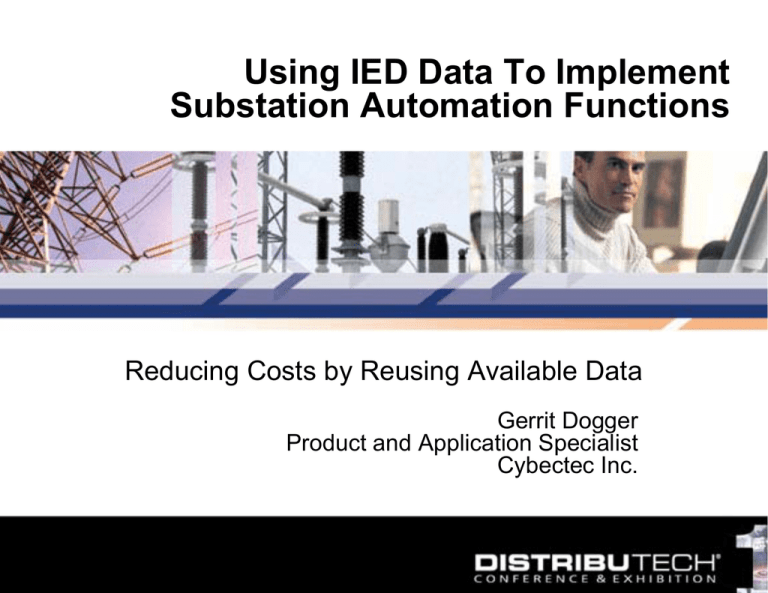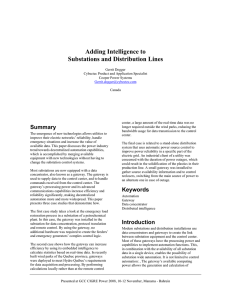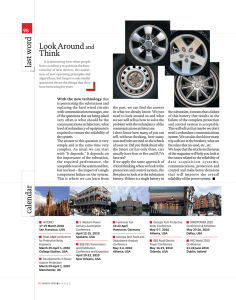Using IED Data To Implement Substation Automation Functions Gerrit Dogger
advertisement

Using IED Data To Implement Substation Automation Functions Reducing Costs by Reusing Available Data Gerrit Dogger Product and Application Specialist Cybectec Inc. Objectives 2 Where are we and what is needed The benefits of using IED data Discussion of challenges and their solutions Discussion of future developments Real-world case study: Emergency power management and load restoration Substation Evolution 1/2 SCADA Existing situation IED RTU 3 PROTECTION METERING POWER QUALITY Substation Evolution 2/2 New situation: IEDs for protection, measurement and control Substation gateway/data concentrator for communication IED PROTECTION 4 METERING POWER QUALITY Automation Requirements Substation automation functions need – 5 Access to all substation data Control capability of substation switchgear A device with programming capability Introducing the Intelligent Gateway A communications gateway provides data access and control capabilities An intelligent gateway also provides automation capabilities Replaced by 6 Direct Benefits of the Intelligent Gateway 7 No PLC or other additional devices needed Fewer devices reduce administrative costs No additional cabling – IEDs are already connected Opportunity for optimized price/performance relay configuration Reinforced by the additional intelligence Simplified substation architecture – vendor independent Indirect Benefits of the Intelligent Gateway These might be more important in the long run – 8 Simpler diagrams because of reduced cabling Less maintenance on diagrams Fewer devices means Fewer spare parts Less training Challenges and Their Solutions Using intelligent gateways introduces new challenges – 9 Response times Exception handling Supporting redundancy Response Times – Issues Data acquisition delays due to communication between gateway and IED Delay in command execution Note: Immediate faults are handled by the IED. 10 Response Times – Solutions Modern protocols reduce data acquisition delays – 11 DNP3, IEC 60870-5-101, IEC 60870-5-104 use unsolicited reporting Response Times – Solutions Processor/task priority reduce the command delay – 12 High priority for Automation tasks Command handling IED command handling Exception Handling – Issues Special care needs to be taken for – 13 Invalid incoming data Command execution error handling Exception Handling – Solutions Data invalidity can be handled by – 14 Checking individual data point quality Checking the communication link status Exception Handling – Solutions For command execution – 15 Check the protocol command acknowledgement Check the corresponding indications Supporting Redundancy – Issues Redundancy introduces additional challenges – 16 Correct handling of failover situations Synchronization of data between the programs No or limited concurrent execution Supporting Redundancy – Solutions To ensure correct execution – 17 Plan redundancy from the start Use internal program indications Use external indications – binary inputs Supporting Redundancy – Solutions 18 Fast failover needs data synchronization Gateway must address this issue Supporting Redundancy – Solutions 19 Both synchronized gateways might execute the program. Highly undesirable Should be solved in the design Future Developments Some trends we see developing: 20 IEC 61850 – GOOSE messages can optimize interaction Communication availability Substations can share more data This enables region-wide automation Real-World Case Study: Emergency Power Management and Load Restoration Incomer #1 Incomer #2 EDG #1 EDG #2 EDG #3 52R-2 52L-3 52L-2 52L-1 52R-1 52L-R NO F1 21 F2 F16 F17 REDUNDANT CONTROL CENTERS REDUNDANT GATEWAYS EDG MCP INCOMER UNDERVOLTAGE PLCS GENERATOR BREAKER IEDS 22 FEEDER IEDS Start state Initialization and C: Start of SMP A: Initialize system IDLE state C: One or both incomers closed & C: `Permissive to syn and close EDG`s CBs` A: Reset `Permissive to syn and close EDG`s CBs IDLE C: Both incomers open & C: NOT `Permissive to syn and close EDG`s CBs` A: Open feeders C: Both incomers open & C: `Permissive to syn and close EDG`s CBs` Wait for feeders to open C: One or both incomers closed Blackout: open feeders C: (Both incomers open & C: All feeders open & C: Bus load less than 1 MW) OR C: FeederOpenTimer timout (10 sec) A: Set `Permissive to syn and close EDG`s CBs Wait for power from generators C: One or both incomers closed Feeders open: Start generators C: 1 or more EDG`s CB s closed A: Calculate power A: Determine next feeder C: All feeders Done & C: Retrycounter < 3 A: Retrycounter := Retrycounter + 1 Retry feeders that didn’t close C: One or both incomers closed Closing feeders C: Power is available A: Calculate power A: Close selected feeder Determine Close Fail Wait for close confirmation C: Feeders to retry deteminated A: Determine next feeder C: One or both incomers closed 23 C: (Feeder is closed || timeout (5sec)) & C: Not all feeder are closed A: Determine next feeder Power: Close feeders (priority based) Emergency Power Management and Load Restoration Basic facts 24 Put into service in November 2005 Normal conditions: restore power within 1 minute Mainly waiting for generators to come online Failover condition: restore power within 1.5 minutes Concluding Remarks Benefits 25 No additional hardware Uses existing data and wiring Fewer spare parts Lower administration costs – Minimal training needed Everything is available to implement it now Proven concept Concluding Remarks Development 26 Better interaction using IEC 61850 GOOSE messages Upcoming opportunities for region-wide automation Contact Information Gerrit Dogger Product and Application Specialist Cybectec Inc. Gerrit.Dogger@Cybectec.com 27 Questions? 28







